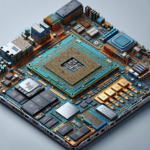How Multi-Core CPUs Enhance Multitasking Capabilities

Introduction
In the ever-evolving landscape of computing, the demand for faster and more efficient processing capabilities has never been higher. One of the most significant advancements in this domain is the development of multi-core CPUs. These processors have revolutionized the way computers handle multitasking, enabling users to run multiple applications simultaneously without compromising performance. This article delves into how multi-core CPUs enhance multitasking capabilities, exploring the underlying technology, benefits, and real-world applications.
Understanding Multi-Core CPUs
What is a Multi-Core CPU?
A multi-core CPU is a single computing component with two or more independent processing units called “cores.” Each core can execute instructions independently, allowing for parallel processing. This architecture contrasts with single-core CPUs, where only one core handles all tasks, leading to potential bottlenecks when running multiple applications.
Evolution of Multi-Core Technology
The transition from single-core to multi-core CPUs was driven by the need to overcome the limitations of increasing clock speeds. As clock speeds approached their physical limits, manufacturers turned to multi-core designs to boost performance. This shift began in the early 2000s, with companies like Intel and AMD leading the charge. Today, multi-core CPUs are standard in most computing devices, from smartphones to high-performance servers.
How Multi-Core CPUs Enhance Multitasking
Parallel Processing
One of the primary ways multi-core CPUs enhance multitasking is through parallel processing. Each core can handle a separate task or thread, allowing multiple processes to run concurrently. This capability is particularly beneficial for applications that can be divided into smaller, independent tasks, such as video rendering, scientific simulations, and data analysis.
Load Balancing
Multi-core CPUs can distribute workloads more evenly across cores, preventing any single core from becoming a bottleneck. This load balancing ensures that all cores are utilized efficiently, leading to smoother and faster performance. Modern operating systems and software are designed to take advantage of this feature, dynamically allocating tasks to different cores based on their current load.
Improved Responsiveness
With multiple cores at their disposal, systems can handle background tasks without affecting the performance of foreground applications. For example, a user can run a virus scan, download files, and stream a video simultaneously without experiencing significant slowdowns. This improved responsiveness is crucial for maintaining productivity and a seamless user experience.
Energy Efficiency
Multi-core CPUs can also enhance energy efficiency. By distributing tasks across multiple cores, each core can operate at a lower clock speed, reducing power consumption and heat generation. This efficiency is particularly important for mobile devices, where battery life is a critical factor.
Real-World Applications of Multi-Core CPUs
Gaming
Modern video games are highly demanding in terms of processing power. Multi-core CPUs allow games to run more smoothly by distributing tasks such as physics calculations, AI processing, and rendering across multiple cores. This parallelism results in higher frame rates and more immersive gaming experiences.
Content Creation
Tasks like video editing, 3D rendering, and graphic design benefit significantly from multi-core CPUs. Software applications in these fields are designed to leverage multiple cores, enabling faster rendering times and more efficient workflows. For instance, Adobe Premiere Pro and Blender can utilize multiple cores to speed up video rendering and 3D modeling tasks.
Scientific Computing
Scientific research often involves complex simulations and data analysis that require substantial computational power. Multi-core CPUs enable researchers to run simulations faster and analyze large datasets more efficiently. Applications in fields such as genomics, climate modeling, and particle physics benefit immensely from the parallel processing capabilities of multi-core CPUs.
Virtualization
Virtualization technology allows multiple operating systems to run on a single physical machine. Multi-core CPUs enhance virtualization by allocating separate cores to different virtual machines, ensuring that each VM operates smoothly without interfering with others. This capability is essential for cloud computing and enterprise environments where resource efficiency and isolation are critical.
Challenges and Considerations
Software Optimization
While multi-core CPUs offer significant advantages, their full potential can only be realized if software is optimized to take advantage of multiple cores. Not all applications are designed for parallel processing, and some may not see substantial performance gains on multi-core systems. Developers must write code that can efficiently distribute tasks across multiple cores to harness the benefits of multi-core CPUs.
Thermal Management
As the number of cores in a CPU increases, so does the heat generated. Effective thermal management is crucial to prevent overheating and ensure stable performance. Manufacturers employ various cooling solutions, such as heat sinks, fans, and liquid cooling systems, to manage the thermal output of multi-core CPUs.
Cost
Multi-core CPUs are generally more expensive than their single-core counterparts. While the cost has decreased over time, high-end multi-core processors can still be a significant investment. Consumers and businesses must weigh the benefits of enhanced multitasking capabilities against the cost when choosing a CPU.
FAQ
What is the difference between a single-core and a multi-core CPU?
A single-core CPU has one processing unit that handles all tasks sequentially, while a multi-core CPU has multiple processing units (cores) that can execute tasks concurrently. This parallelism allows multi-core CPUs to handle multiple applications more efficiently.
How do multi-core CPUs improve gaming performance?
Multi-core CPUs improve gaming performance by distributing tasks such as physics calculations, AI processing, and rendering across multiple cores. This parallel processing results in higher frame rates and smoother gameplay.
Are all software applications optimized for multi-core CPUs?
No, not all software applications are optimized for multi-core CPUs. While many modern applications are designed to take advantage of multiple cores, some older or less complex software may not see significant performance gains on multi-core systems.
What are the benefits of multi-core CPUs for content creation?
Multi-core CPUs benefit content creation by enabling faster rendering times and more efficient workflows. Applications like video editing, 3D rendering, and graphic design can leverage multiple cores to speed up processing tasks.
How do multi-core CPUs enhance virtualization?
Multi-core CPUs enhance virtualization by allocating separate cores to different virtual machines (VMs). This allocation ensures that each VM operates smoothly without interfering with others, which is essential for cloud computing and enterprise environments.
What are the challenges associated with multi-core CPUs?
Challenges associated with multi-core CPUs include software optimization, thermal management, and cost. Not all software is designed for parallel processing, effective cooling solutions are necessary to manage heat, and multi-core CPUs can be more expensive than single-core processors.
Conclusion
Multi-core CPUs have transformed the computing landscape by significantly enhancing multitasking capabilities. Through parallel processing, load balancing, improved responsiveness, and energy efficiency, these processors enable users to run multiple applications simultaneously without compromising performance. Real-world applications in gaming, content creation, scientific computing, and virtualization demonstrate the tangible benefits of multi-core technology. However, challenges such as software optimization, thermal management, and cost must be considered. As technology continues to advance, multi-core CPUs will undoubtedly play a crucial role in meeting the growing demands for faster and more efficient computing.




